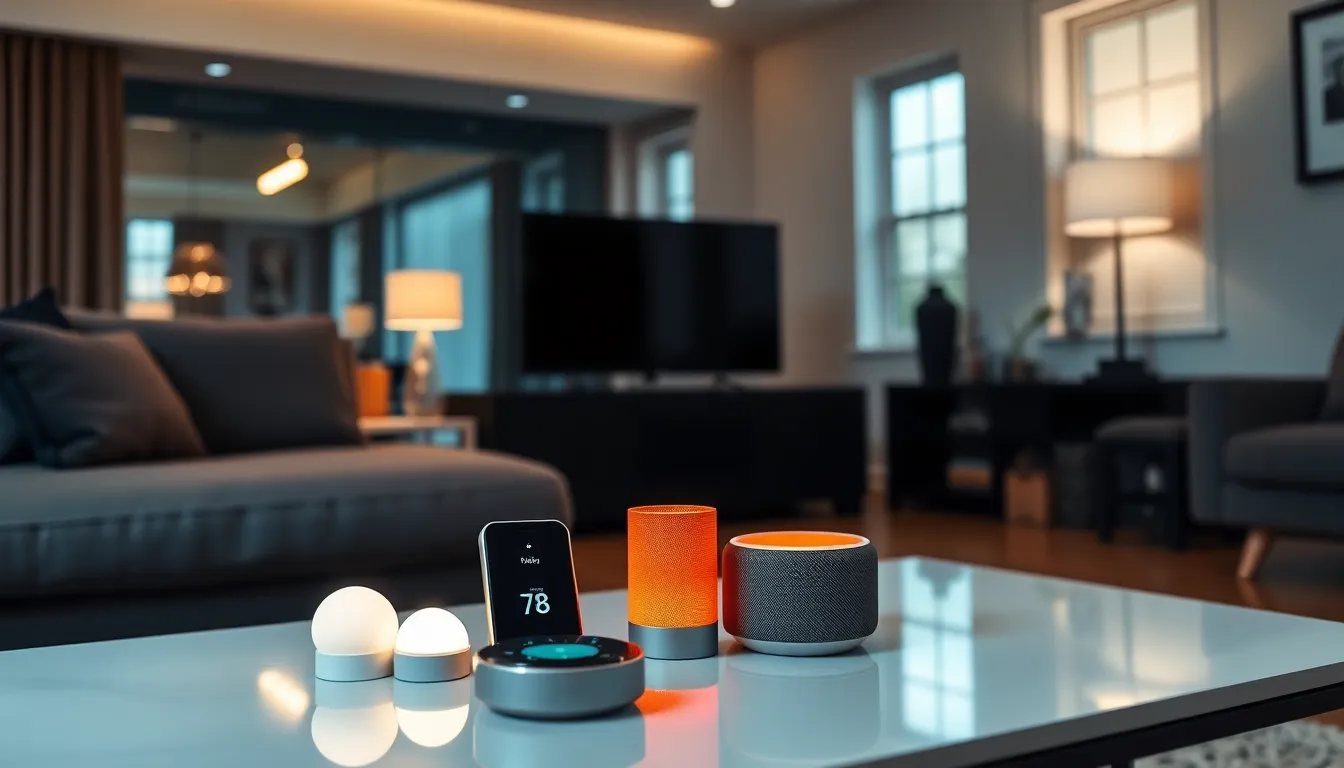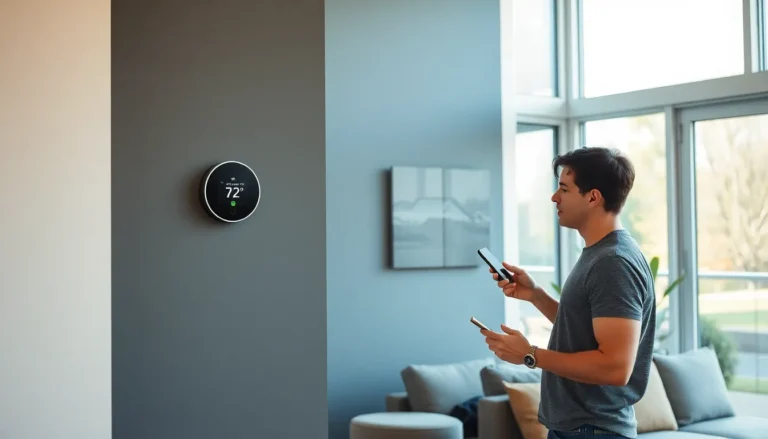Table of Contents
ToggleImagine walking into your home and having the lights turn on, the thermostat adjust, and your favorite playlist start playing—all without lifting a finger. Sounds like something out of a sci-fi movie, right? Welcome to the world of wireless home automation, where convenience meets cutting-edge technology in a way that even your most tech-challenged relative could appreciate.
Overview of Wireless Home Automation
Wireless home automation integrates smart technology into daily living, offering seamless control over various devices. This system enhances convenience and efficiency, allowing users to manage their homes remotely.
What Is Wireless Home Automation?
Wireless home automation refers to the use of wireless technology to monitor and control home systems. It encompasses devices like smart lights, thermostats, and security cameras. Communication often involves protocols such as Wi-Fi, Zigbee, or Z-Wave. Users operate these devices through smartphones or tablets, enabling centralized management. The setup requires minimal wiring, making installation straightforward. This technology supports various applications, from energy management to enhanced security.
Benefits of Wireless Home Automation
Wireless home automation delivers numerous advantages compared to traditional systems. Increased convenience ranks high, as users can remotely manage devices, saving time and effort. Improved energy efficiency results from smart thermostats adjusting based on habits. Enhanced security features include real-time alerts and remote camera access, providing peace of mind. Customization options allow users to tailor scenarios and routines per their preferences. Finally, scalability enables easy additions of new devices, ensuring the system grows with changing needs.
Key Components of Wireless Home Automation
Wireless home automation consists of several key components that contribute to its functionality and effectiveness. Understanding these components aids in implementing a system tailored to individual needs.
Smart Devices and Appliances
Smart devices and appliances form the backbone of wireless home automation systems. Smart lights enable users to adjust brightness and color remotely. Smart thermostats optimize energy usage by learning household patterns. Security cameras offer real-time surveillance accessible via smartphones. Other notable devices include smart locks, which enhance security by allowing keyless entry, and smart speakers, which provide voice control capabilities. These devices enhance comfort and convenience in daily life while allowing centralized control from a single app.
Communication Protocols
Communication protocols facilitate the interaction between smart devices. Wi-Fi serves as a common standard for many home automation systems, providing high-speed connectivity. Zigbee operates on low power, enabling devices to communicate efficiently over short distances. Z-Wave offers strong mesh networking capabilities, enhancing range and reliability. Bluetooth is another option, suitable for short-range control of devices. Each protocol has unique attributes, allowing users to choose systems that best fit their particular requirements.
Popular Wireless Home Automation Systems
Wireless home automation systems enable seamless interaction among devices, enhancing user experience. Several popular platforms make remote management accessible and intuitive.
Amazon Alexa
Amazon Alexa serves as a central hub for smart home devices, allowing voice control and automation. Users can manage compatible devices such as lights, thermostats, and security systems with simple voice commands. Alexa integrates with numerous third-party devices, enhancing compatibility and offering a wide range of automation options. Routines can be easily set up to automate daily tasks, such as adjusting the thermostat or turning off lights at bedtime. Accessing and managing devices is straightforward through the Alexa app, promoting user convenience.
Google Home
Google Home provides robust control over smart devices using voice commands or the Google Home app. Integration with various smart products, including lights, cameras, and smart plugs, creates a cohesive smart home environment. Users can customize routines, enabling automation for preferred activities like setting morning alarms or controlling entertainment systems seamlessly. Voice recognition capabilities allow Google Home to respond to multiple users, personalizing interactions and commands. Regular software updates enhance functionality, ensuring it keeps pace with evolving technology.
Apple HomeKit
Apple HomeKit focuses on secure automation for Apple users, leveraging the Home app for centralized device management. HomeKit’s compatibility with a range of devices, including smart lights, locks, and sensors, provides flexibility in creating custom automation scenarios. Users benefit from advanced privacy features, ensuring data security while controlling devices remotely. Siri integration facilitates easy voice commands, allowing users to manage their smart home effortlessly. Setting up automations is intuitive, with options to create custom scenes or schedules based on specific triggers.
Security Considerations in Wireless Home Automation
Wireless home automation brings numerous advantages, but it also presents security challenges that require attention. Users benefit from understanding these challenges to ensure a safe smart home environment.
Protecting Your Network
Securing the home network forms the foundation of effective wireless home automation. Users should employ strong, unique passwords for routers and smart devices. Additionally, enabling WPA3 encryption enhances the protection against unauthorized access. Regularly updating firmware on devices helps neutralize vulnerabilities caused by outdated software. Monitoring the network for unfamiliar devices can also prevent intrusion. Firewalls provide an extra layer of defense against cyber threats. Furthermore, segmenting the network to separate smart devices from personal devices reduces risks significantly.
Device Vulnerabilities
Awareness of device vulnerabilities is crucial for maintaining security in wireless home automation. Many smart appliances may lack robust security features, making them potential entry points for hackers. Users should research devices for security certifications such as UL or CSA. Utilizing two-factor authentication when available strengthens access control significantly. Regularly reviewing device permissions ensures that apps only have necessary access. Users must also remove unused devices to limit potential attack vectors. Lastly, changing default credentials on devices enhances security by making unauthorized access far more challenging.
Future Trends in Wireless Home Automation
Wireless home automation continues to evolve, focusing on enhanced integration and cutting-edge technology. The following trends highlight significant advancements shaping this domain.
Integration with IoT
Integration with IoT (Internet of Things) will streamline communication among devices. Smart appliances, including refrigerators and washing machines, can connect with home systems for seamless experiences. Data exchange between devices leads to personalized automation based on usage patterns. Users can control multiple appliances remotely through a single platform, improving efficiency and convenience. Emerging IoT standards enable interoperability across brands, enhancing user experience further. As this integration advances, homes become more adaptive, responding intuitively to occupant needs.
Advancements in Technology
Advancements in technology drive the future of wireless home automation. Machine learning algorithms enhance automation by predicting user behavior. For example, smart thermostats can learn preferences and adjust heating and cooling accordingly, optimizing energy use. Enhanced security solutions, including facial recognition and AI-driven surveillance, ensure safety without compromising privacy. Voice recognition technology improves commands and interactions, making control more effortless. Improved battery life and lower energy consumption support longer-lasting devices, reducing maintenance efforts. These technological advancements create smarter, more connected homes, elevating the overall user experience.
Conclusion
Wireless home automation represents a significant leap towards a more convenient and efficient lifestyle. By integrating smart technology into everyday living, it empowers users to manage their homes effortlessly. With platforms like Amazon Alexa, Google Home, and Apple HomeKit, the possibilities for customization and control are virtually limitless.
As technology continues to evolve, the future of wireless home automation looks promising. Enhanced integration with the Internet of Things and advancements in machine learning will further enrich user experiences. By prioritizing security and adopting best practices, homeowners can enjoy the benefits of a smart home while ensuring their systems remain safe and secure. Embracing this technology not only simplifies daily tasks but also transforms homes into intelligent environments tailored to individual needs.








